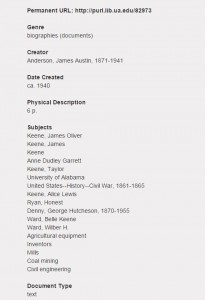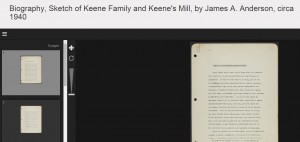By: Donnelly Walton, Archival Access Coordinator
This fall, two Special Collections staff members received honors and promotions. Kevin Ray was promoted to Institutional Records Analyst and April Burnett became the Division of Special Collections’ only certified archivist.
April Burnett joined the University Libraries in 2007 when she interned with Doug Boyd, the former head of digital collections. She already had obtained a Master’s degree in public administration from UA, and in late 2007 she graduated from the School of Library and Information Studies with an MLIS. In January 2008, she accepted the position of archival technician in the Hoole Library, a position she has held since then. As an archival technician, April first learned how to arrange and describe manuscript collections so that she would understand the larger picture of archives. Through the years she increased her knowledge base and skillset by taking additional courses on preservation and archival practice.
Her position is responsible for creating item-level metadata of Special Collections materials that are included in the Libraries’ Digital Collections. After other staff in Special Collections select a collection for inclusion in the digital program, April examines every item that will be digitized, and at the bare minimum, assigns a title to that item. She inputs that title, along with a number of other pieces of data about the item, in a spreadsheet developed by Cataloging and Metadata Services. Searching for that item in Acumen is then pretty easy!
Yesterday a patron asked me if I was familiar with an unpublished biography of the Keene family in Tuscaloosa. The patron had seen it at some point on her many visits to the Hoole Library, but she couldn’t recall how she stumbled upon it. With more than 8000 linear feet of manuscript materials at the Hoole Library, it’s impossible to remember every item. A search of our finding aids and our in-house database found nothing—archivists don’t typically describe materials at the item-level and instead describe materials at the collection, series, box, or folder level. When I keyed “Keene family” in the search bar of Acumen, the University Libraries’ portal for digital collections, the first hit was for “Biography, Sketch of Keene Family and Keene’s Mill, by James A. Anderson, circa 1940” in the James A. Anderson papers. Bingo!
Thanks to April’s work, we and our patrons are able to locate items, along with their digital images, that earlier would have required the patron to spend an inordinate amount of time searching our materials. April must read letters, diaries, receipts, deeds, and various legal and financial documents to decipher names and dates, as well as the general content of a document. Since we primarily digitize materials that are in the public domain, a great number of these items are written in nineteenth-century script and often very difficult to read. She amazingly has provided the item descriptions for over 71,000 items—an item might be a postcard, or it could be a ten-page letter. Her work often requires her to conduct research to discover the identity of the writer and to inform the creation of names for our database. April is, of course, only one person in the digital program—numerous people in several Libraries departments work to make it easy for patrons to find their materials. Her portion is the first and very visible step in the larger process.
After receiving training from Cataloging & Metadata Services a few years ago, April is now able to add very important subjects and names to our finding aids to add another level of discovery and standardization to our finding aids and collection records in Special Collections. So far, she has added over 1000 names and subjects for us.
This summer she applied to sit for the Academy of Certified Archivists’ examination, which just happened to be in Tuscaloosa. The Academy of Certified Archivists (ACA) was established in 1989 to “develop and administer a program of certification and certification maintenance for archivists in the United States and internationally; increase knowledge of archival certification and its benefits within and outside the archival profession; and promote among archivists the attainment of a high level of professional knowledge.” Anyone interested in becoming a certified archivist must apply and gain approval from the ACA to take the test, and upon approval, sit for the exam in one of several designated sites each year. Only archivists with the requisite amount of experience and qualifying educational background may take the exam. The rigorous exam tests the applicant’s knowledge of archival history, theory, practice, and management.
April took the exam in August and recently received confirmation that she passed the examination and is now a certified archivist! She is the only certified archivist in the Division of Special Collections. We are all so proud of her and this accomplishment!



